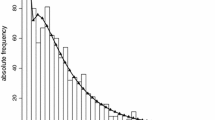Abstract
The paper examines whether productivity differences among individual researchers are larger in some fields of learning than in others. Productivity patterns in the natural sciences, the medical sciences, the social sciences, and the humanities are compared by the use of unweighted and weighted publication counts. Irrespective of whether total number of publications or a refined indicator taking account of type of publication and multiple authorship are used, there are no essential differences in publishing inequality between the various fields. About 20% of the tenured faculty at Norwegian universities produce 50% of the total output, and the most prolific half of the researchers account for almost 85% of the output. The results are discussed in relation to Lotka's law.
Similar content being viewed by others
References
A. J. LOTKA, The frequency distribution of scientific productivity,Journal of the Washington Academy of Sciences, 16 (1926) 317.
J. VLACHY, Frequency distribution of scientific performance: a bibliography of Lotka's law and related phenomena,Scientometrics, 1 (1978) 109.
D. De SOLLA PRICE,Little Science, Big Science, Columbia University Press, New York, 1963.
W. G. POTTER, Lotka's law revisited,Library Trends, 30 (1981) 21.
P. D. ALLISON,Processes of Stratification in Science, Arno Press, New York, 1980.
M. L. PAO, Lotka's law: a testing procedure,Information Processing and Management, 21 (1985) 305.
W. GLÄNZEL, A. SCHUBERT, Price distribution. An exact formulation of Price's “square root law”,Scientometrics 7 (1985) 211.
J. R. COLE, S. COLE,Social Stratification in Science, The University of Chicago Press, Chicago, 1973.
P. D. ALLISON, J. A. STEWART, Productivity differences among scientists: Evidence for accumulative advantage,American Sociological Review, 39 (1974) 596.
M. TROW, O. FULTON, Research activity in American higher education, in:Teachers and Students. Aspects of American Higher Education, M. TROW (Ed.), McGraw-Hill Book Company, New York, 1975.
B. F. RESKIN, Scientific productivity and the reward structure of science,American Sociological Review, 42 (1977) 491.
J. GASTON,The Reward System in British and American Science, John Wiley & Sons, New York, 1978.
J. R. COLE,Fair Science. Women in the Scientific Community, The Free Press, New York, 1979.
J. R. COLE, H. ZUCKERMAN, The productivity puzzle: Persistence and change in patterns of publication of men and women scientists, in:Advances in Motivation and Achievement, P. MAEHR, M. W. STEINKAMP (Eds.), 2 (1984) 217, JAI Press.
L. J. MURPHY, Lotka's law in the humanities?Journal of the American Society for Information Science 24 (1973) 461.
UNESCO,Recommendations concerning the international standardization of statistics on science and technology, UNESCO, Paris, 1978.
D. De SOLLA PRICE, de B. BEAVER, Collaboration in an invisible college,American Psychologist, 21 (1966) 1011.
H. ZUCKERMAN, Patterns of name ordering among authors of scientific papers: A study of social symbolism and its ambiquity,American Journal of Sociology, 74 (1968) 276.
E. RUDD, The effect of alphabetical order of author listing on the careers of scientists,Social Studies of Science, 7 (1977) 268.
E. GARFIELD, More on the ethics of scientific publication: abuses of authorship attribution and citation amnesia undermine the reward system of science, in: E. GARFIELD,Essays of an information scientist, 5 (1982) 621.
G. ARNISON, et al, Experimental observation of lepton pairs of invariant mass around 95 GeV/c2 at the CERN SPS collider,Physics Letters 126b (1983) 398.
A. E. NUDELMAN, C. E. LANDERS, The failure of 100 divided by 3 to equal 33-1/3,The American Sociologist, 7 (1972) 9.
H. ZUCKERMAN, R. K. MERTON, Patterns of evaluation in science: institutionalisation, structure and function of the referee system,Minerva, 9 (1971) 66.
M. D. GORDON, A critical reassessment of inferred relations between multiple authorship, scientific collaboration, the production of papers and their acceptance for publication,Scientometrics, 2 (1980) 193.
S. PRESSER, Collaboration and the quality of research,Social Studies of Science, 10 (1980) 95.
S. M. LAWANI, Some bibliometric correlates of quality in scientific research,Scientometrics, 9 (1986) 13.
D. LINDSEY, Production and citation measures in the sociology of science: The problem of multiple authorship,Social Studies of Science, 10 (1980) 145.
J. S. LONG, R. McGINNIS, P. D. ALLISON, The problem of junior-authored papers in constructing citation counts,Social Studies of Science, 10 (1980) 127.
D. LINDSEY, Further evidence for adjusting for multiple authorship,Scientometrics, 4 (1982) 389.
P. D. ALLISON, Inequality and scientific productivity,Social Studies of Science, 10 (1980) 163.
S. KYVIK,Arbeidsoppgaver og arbeidstid, Institute for Studies in Research and Higher Education, Oslo, 1983.
M. L. PAO, An empirical examination of Lotka's law,Journal of the American Society for Information Science, 37 (1986) 26.
T. AMUNDSEN, S. KYVIK, D. A. AAS-ENG, Publication and citation performance of Norwegian scientists in terrestrial ecology and systematics, in:International Evaluations. Terrestrial Ecology and Systematics in Norway, Council for Natural Science Research, Oslo, 1988.
Author information
Authors and Affiliations
Rights and permissions
About this article
Cite this article
Kyvik, S. Productivity differences fields of learning, and Lotka's law. Scientometrics 15, 205–214 (1989). https://doi.org/10.1007/BF02017199
Received:
Issue Date:
DOI: https://doi.org/10.1007/BF02017199




